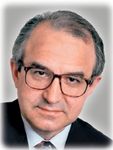Article
Post-RP radiation improves progression-free survival
Paris--External irradiation immediately following radical prostatectomy appears to improve biochemical progression-free survival and local control in prostate cancer patients at high risk of progression, according to results of a study from the European Organization for Research and Treatment of Cancer (EORTC).
Paris-External irradiation immediately following radical prostatectomy appears to improve biochemical progression-free survival and local control in prostate cancer patients at high risk of progression, according to results of a study from the European Organization for Research and Treatment of Cancer (EORTC).

The study, presented at the European Cancer Conference here, included 1,005 patients with a median age of 65 years and with one or more pathologic risk factors (capsule perforation, positive surgical margins, invasion of seminal vesicles). Patients were randomized to immediate radiotherapy with a total dose of 60 Gy for 6 weeks after radical prostatectomy, or to deferred radiotherapy until local recurrence. Demographics and clinical characteristics were well balanced between the two arms. Prior to surgery, median PSA level was 12.3 ng/mL.
Locoregional failure was significantly lower in the radiotherapy arm as well: 5.4% versus 15.4% at 5 years. The rate of severe toxicity (grade 3 or higher) was relatively low in the radiotherapy arm: 4.2% versus 2.6% for the observation arm.
"This was a surprise for the surgeons, but not for the radiation oncologists," Dr. Bolla said.
However, late grade 2 or 3 effects were more frequent in the radiotherapy arm than in the observation arm.
'Impressive' survival data
D.P. Dearnaley, MD, Sutton, UK, formal discussant of the EORTC trial, said that this was the first published and reported randomized controlled trial of postoperative radiotherapy in prostate cancer extending beyond the capsule (pT3).
"The study showed impressive progression-free survival," Dr. Dearnaley said.
Following surgery, 30% had PSA levels >0.2 ng/mL and 70% had PSA <2.0 ng/mL, and the treatment effect for postoperative radiotherapy was similar regardless of PSA level.
At this point, he said, there is relatively little difference between the two treatment arms in the percentage of patients with distant metastasis and deaths due to prostate cancer. The incidence of late side effects was also increased in the radiotherapy arm.
"We need more follow-up to determine whether the earlier endpoints will lead to reduced metastasis and increased survival," Dr. Dearnaley said.
Newsletter
Stay current with the latest urology news and practice-changing insights — sign up now for the essential updates every urologist needs.















